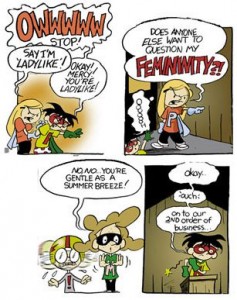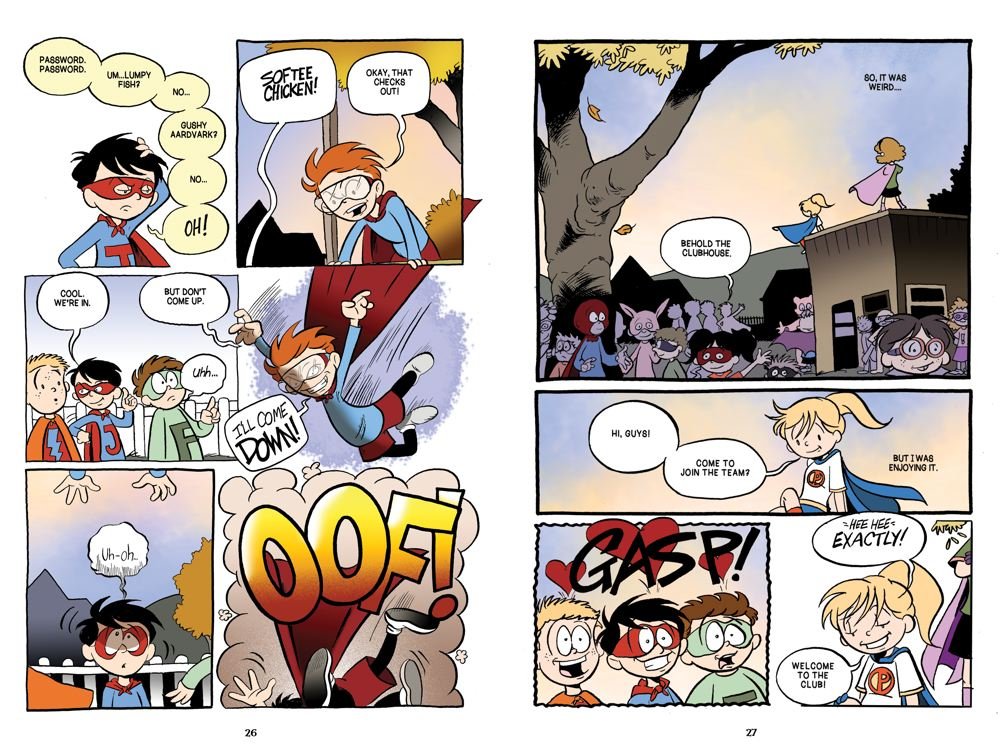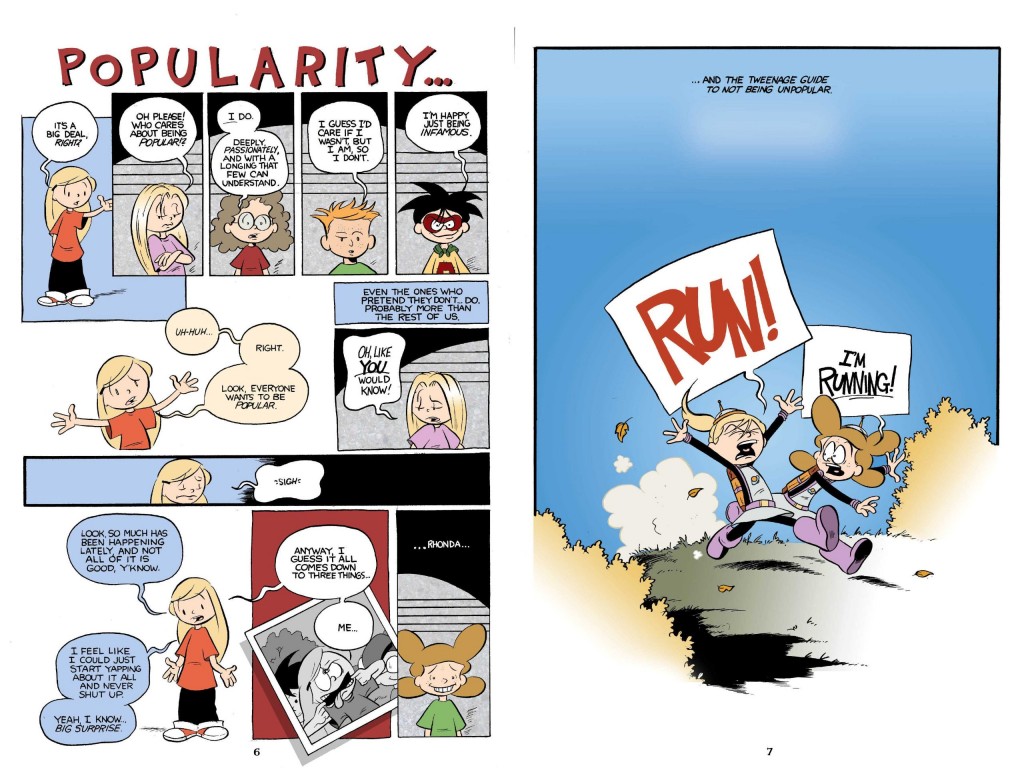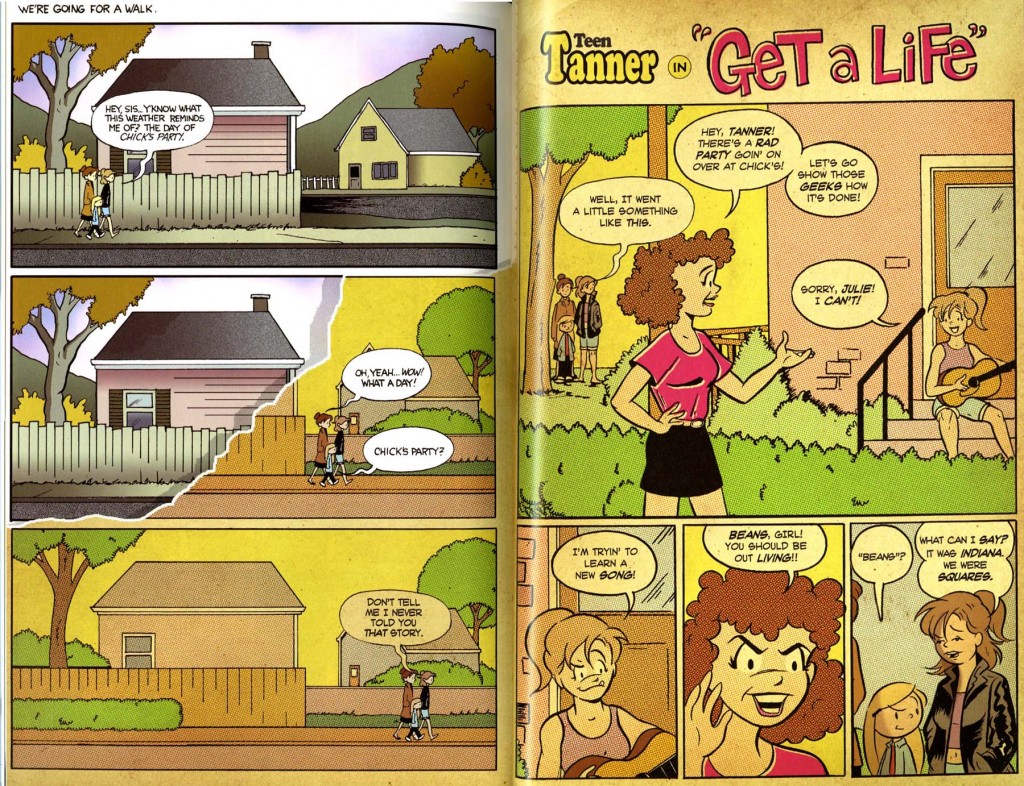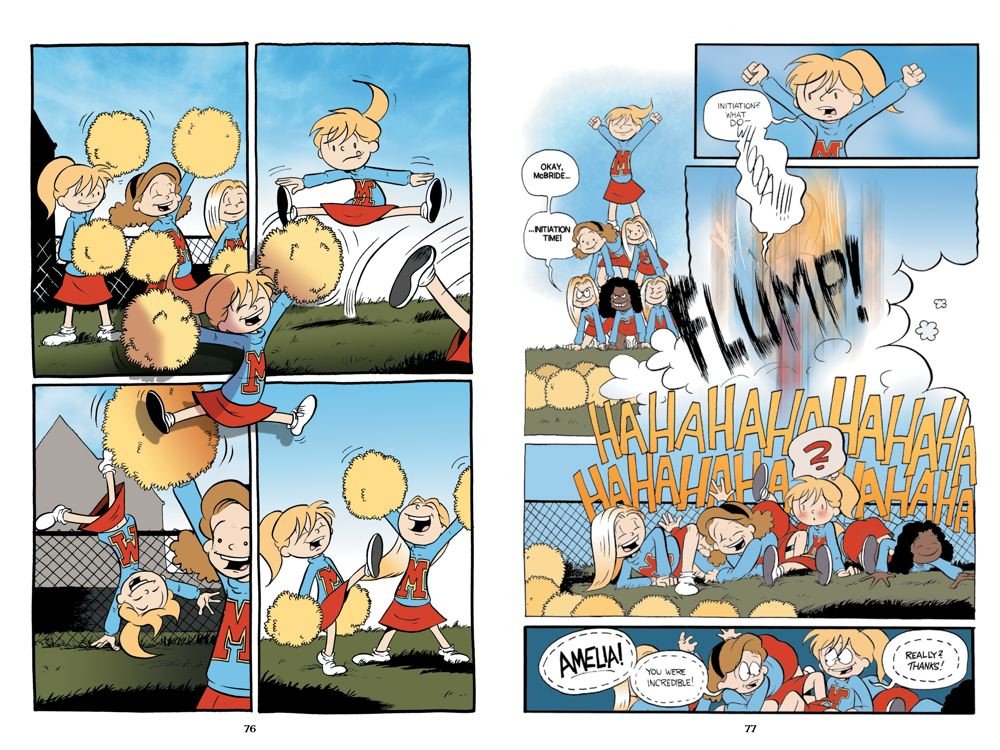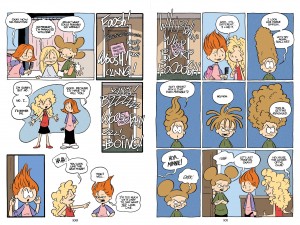Welcome to Using Graphic Novels in Education, an ongoing feature from CBLDF that is designed to allay confusion around the content of graphic novels and to help parents and teachers raise readers. In this column, we examine graphic novels, including those that have been targeted by censors, and provide teaching and discussion suggestions for the use of such books in classrooms.
This post takes a closer look at the Amelia Rules series by Jimmy Gownley
“One thing I noticed about grown-ups…They’re not funny!”
— Amelia, The Whole World’s Crazy by Jimmy Gownley
While the quote may hold true for most adults, it certainly does not hold true for Jimmy Gownley. His Amelia Rules! series is full of laughs, insights, and loads of fun.
Amelia Rules! is a New York Times bestseller. It has been nominated for 13 Eisner Awards (four nominations in 2008 alone), has been nominated for five Harvey Awards, and was a short list finalist for the Howard E. Day Prize in 2002. In 2007, Volume 3: Superheroes won the Cybil Award for best graphic novel for readers aged 12 and under. In 2008, Gownley won the Pennsylvania Library Association One Book Award, and in 2012, Volume 8: Her Permanent Record became the first Amelia Rules! book to make the New York Times bestseller list.
There are eight books in the Amelia Rules! series:
- The Whole World’s Crazy
- What Makes You Happy
- Superheroes
- When the Past Is a Present
- The Tweenage Guide to Not Being Unpopular
- True Things (Adults Don’t Want Kids to Know)
- The Meaning of Life and Other Stuff
- Her Permanent Record
Table of Contents
- OVERVIEW
- SUMMARY
- TEACHING/DISCUSSION SUGGESTIONS
- COMMON CORE STATE STANDARDS (CCSS)
- ADDITIONAL RESOURCES
OVERVIEW
Amelia Rules! is an empowering, heart-warming story about Amelia Louise McBride, who moves with her Mom to a small town in Pennsylvania to live with her uber-cool aunt Tanner after her parents’ divorce. Amelia, along with her friends Reggie, Pajamaman (or PJ), and Rhonda Bleenie (Amelia’s best frenemy) take on the world with some guidance from Tanner, a former rock-star. Through laughs, challenges, and spills, we learn about friendship, family, the “truths” of life, and the joys of not taking anything too seriously — as long as there are people (as flawed as they may be) to provide support when necessary.
Throughout the series, Amelia and her friends deal with divorce, bullies, death, stardom, and just about everything Gownley throws at them. From beginning to end, the series shows us how to gracefully and not-so-gracefully embrace life.
Aside from the wonderful truths and laughs that fill these pages, Gownley also creates a rich visual world for us to savor. While his characters are simply drawn (much like Charles Schulz’s Peanuts and Bill Watterson’s Calvin and Hobbes), they are by no means simple. The image, panel, and page design are dazzling. They’re vibrant, colorful, and casual, and the overall panel elements are brilliant as Gownley scaffolds levels of insight and storytelling through image, font, color, design, and text. Gownley seemingly effortlessly weaves present, past, and future with references to Scott McCloud, Bob Dylan, and other glorious and not-so-glorious pop culture references.
While these books are geared for 7- to 12-year-olds, they are wonderfully entertaining for readers of all ages and provide summer, school, or any-time fun.
SERIES SUMMARY
The Whole World’s Crazy — Nine-year-old Amelia and her mom move from New York City to small-town Pennsylvania before the start of fourth grade. Together, Amelia and her friends survive bullies, gym class (barely), Halloween, Christmas, and camping with Amelia’s dad.
What Makes You Happy — Tanner, Amelia, and her friends all discover what really makes them happy as they reflect on their pasts and futures. They deal with school, successes, failures, dreams, spin the bottle, and even a brush with death.
Superheroes — Amelia faces the prospect of having to move, Reggie uncovers the evil Legion of Steves, and the friends play a frightful game of Truth or Dare.
When the Past Is a Present — It’s a new school year, and Rhonda wants to start it off on a new foot. This year involves a school dance and a friend having to deal with her father being deployed overseas. At the same time, Amelia’s mom is starting to date, which sends Amelia thinking about her past and her family’s past. In the end, Amelia realizes that life’s all about moving on and accepting what can’t be changed, while facing unavoidable issues.
The Tweenage Guide to Not Being Unpopular — A handbook about the dangers and dramas of middle school and the social mine fields that tween-hood entails, this volume is about evaluating good and bad choices, about having perspective, and about tackling image and popularity.
True Things (Adults Don’t Want Kids to Know) — Amelia helps Tanner revive her music career, Rhonda comes to terms with her newfound popularity, Reggie discovers that you can’t remain a kid forever, and Amelia discovers that crushes can be crushing. Through all this, readers learn a lot of truths, including the fact that disappointment, while painful, is a fundamental part of life.
The Meaning of Life and Other Stuff — As Amelia grows up, she learns that nothing lasts forever — not marriage (at least not her parents’ marriage), not Tanner’s support, not even G.A.S.P (the Gathering of Awesome Super Pals). She also learns that while not everything broken can be fixed, you can pick up the pieces and make something else.
Her Permanent Record — Amelia and her friends are now 11 years old, still facing life’s challenges, and learning that life is always full of challenges and surprises. But most importantly, Amelia learns who she is and is happy with it as she eagerly skips off to face life’s ongoing challenges.
In short Amelia Rules! is a story about life’s truths and challenges. The series shows readers that it is ever so much easier to face challenges with friends, family, and a sense of humor. In addition to teaching life lessons, the series is full of gems from literature, music, and philosophy. But most of all, it’s just pure fun!
Throughout Amelia Rule! Jimmy Gownley discusses:
- The ups and downs of friendships, frenemies, bullies, and group stereotypes;
- Learning how to live with and navigate through divorce;
- The fears and challenges of moving;
- Whether Santa Claus is real;
- Dealing with death and fear of funerals;
- How people with disabilities are often treated differently;
- The affect a “bad” label can have and the importance of perspective and being true to oneself;
- Finding what makes us happy;
- Coming of age and learning to balance dreams, flaws, and life’s challenges;
- How to deal with real and imagined dangers, from camping to games like Truth or Dare and Spin the Bottle to a military parent deployed for a year overseas.
TEACHING/DISCUSSION SUGGESTIONS:
Plot, Themes, and Values Related
- Discuss and chart the different themes Mr. Gownley presents in the series.
- Compare and contrast how Gownley relates these themes to the way others, such as Judy Blume, have done in traditional prose texts, or how cartoonists such as Charles Schulz and Bill Watterson, have done it in their comic strips.
- Compare and contrast how the characters and their friendships have developed and changed throughout the series. Discuss different types of friendships one might have with others. Detail what it means to be a good friend. Explain the challenges we face in determining and maintaining friendships and why this is so important.
- In Superheroes, Amelia and her friends are pressured into playing Truth or Dare. Have students discuss what they might do if / when someone pressures them to do or play something they’re not completely comfortable with.
- In Superheroes, Amelia meets a new friend with “ventricular septal defect.” Discuss why Tanner mentions her disability to Amelia and how this affects the way in which Amelia perceives and treats her. Have students discuss people in their lives with various disabilities and how they are treated / perceived.
- In When the Past Is a Present, prayer is an underlying theme (p. 93): “Lord grant us the serenity to accept the things we cannot change…the courage to change the things we can…and the wisdom to know the difference.” This prayer is recited before a Catholic school dance begins (and at their games and classes).
- Address the role of religion and prayer in school and of the issues underlying the separation of church and state.
- Discuss the prayer recited at the dance and how your students might interpret it and live by it.
- In True Things (Adults Don’t Want Kids to Know) Amelia learns that sometimes a thing is so broken that it can’t put it back together again. In The Meaning of Life…and Other Stuff, Amelia learns a corollary: If you can’t put something back together, pick up the pieces and make something new. Brainstorm incidents where something broken can and cannot be put back together, and how if they can’t be restored, whether they can be re-made differently. Use this metaphor for personal as well as for political / historical events.
- In Her Permanent Record, Amelia realizes exactly who and what she is and what she is good at and not so good at, and she comes to terms with all of this as she skips off into the sunset. Have students relate who they are — their likes, dislikes, and quirks and the skills they have to face life’s challenges.
Critical Reading and Making Inferences
- Search and discuss the many wisdom and truths relayed by Tanner and Amelia. You may also want to turn this into a writing exercise, having students work individually, in pairs, or in groups, creating their own truths and insights. Here are some examples:
- The Whole World’s Crazy:
- p. 4: Amelia tells us, “…one thing I’ve noticed about grown-ups. They’re not funny.”
- p. 33: Tanner says, “You know, Amelia, just because your home is broken… that doesn’t mean you have to be.”
- p. 38: Amelia says, “It’s not easy raising a parent these days… you gotta be sharp and aware of every little thing…”
- p. 124: Amelia says, “Any time you find magic I this world, you have to fight hard to keep it.”
- p. 134: Amelia relays, “There is a Santa Claus only sometimes, just sometimes… He needs a little help.”
- What Makes You Happy:
- p. 33: After reading “The Walk to the Moon” by Beth Ellen Welch, Tanner in a sleepy haze tells Amelia, “There’s a true thing adults don’t want kids to know… Wanting something is always better than having it.”
- p. 86:Amelia says, “ I think a lot about the important things in life you only learn by screwing up.”
- p. 135-136: Amelia realizes that, “…We can never really leave… The past is always with you…”
- In When the Past Is a Present Tanner and Mom relay their family history and wisdoms. These wisdoms are combined on page 142 noting that life’s: “..going to be quite risky. After all everything good in life usually is. It’s not just about the adventure though… it’s all about the choices you make…” Discuss and evaluate these wisdoms. You may want students to go home and research their own family’s perceptions about the world or even brainstorm in groups to come up with their own.
- In The Tweenage Guide to Not Being Unpopular (p. 143), Amelia’s mom tells her, “Popularity? It’s just fleeting okay? It comes and goes! It — it doesn’t MEAN anything!”
- In True Things (Adults Don’t Want Kids to Know)
- p. 3: Tanner is quoted (in an interview) saying, “The main difference between boys and girls is that girls mature slightly faster and boys are idiots.”
- p. 31: Rhonda asks (after Tanner sang an incredible song she wrote for Amelia’s birthday), “What’s the point of being able to do something if you never do it?”
- p. 34: Tanner is quoted, “I’m still waiting to use algebra.”
- p. 61: Tanner is talking to Amelia’s class tell them, “”School is important, but so is play. I learned just as much at recess as I did in algebra.”
- p. 65: Tanner tells Amelia, “A cute, confident girl is much more powerful than a Jedi.”
- p. 70: Tanner is quoted (in another interview) saying, “I think the reason people have kids is so they can pass their own brand of crazy on to the new generation.”
- p. 72: Amelia remembers Tanner telling her, “Just cuz someone’s the boss, that doesn’t mean they don’t know what they’re doing.”
- p. 76: Amelia tells us that for a while (during her parents’ divorce) she went to talk with Dr. Eugene Finster and the truest thing anyone ever told her was Dr. Finster when he said, “Sometimes a thing is broken so badly, there’s just no way to put it back together.”
- p. 104: Tanner (from the liner notes of Broken Record) said, “Art is like a beautiful dream, and the rest of the world is the alarm clock.”
- p. 124: Tanner (in her private journal) writes, “Growing p is the hardest part of growing up, but what choice do we have?”
- p. 158: The page lists various truths. Discuss and evaluate them individually or in groups and have students write their own.
- In The Meaning of Life…and Other Stuff, Tanner (p. 88) remarks that, “Not everything needs to be a grand gesture…not every problem in life can be fixed with a song or a play or a book. Sometimes it’s just the opposite. Sometimes the best way to get someone through the pain of their past or their present is just to be there with them and to hold their hand and wait for the future.”
- In Her Permanent Record, it’s Amelia who lays truths on Tanner (p. 130) “… Life is tough…and sometimes crap happens that you don’t like! But you don’t run! You act like a grown-up!” Discuss what Amelia means by “acting like a grown up” and come up with your own truths about what to do “when crap happens.”
- The Whole World’s Crazy:
- In What Makes You Happy Amelia’s aunt dies and Amelia tells us, “I wasn’t thrilled about going to a funeral…What do you say?” You may want to discuss different cultural/ethnic etiquettes and rituals followed for funerals.
- In The Tweenage Guide to Not Being Unpopular:
- Amelia is told by her Principal Wright, “You are BAD” which leads her to question, “Maybe if you’re bad you’re the last one to know… I bet most bad people who do bad things don’t even think they’re bad…” Discuss the concepts of “bad” and “perspective” with your students.
- Evaluate the “advice” of Victoria St. James Memeochrias “renowned author, scholar, and motivational speaker.”
- In True Things (Adults Don’t Want Kids to Know) p. 86, Amelia and Rhonda go to the mall. It’s the Consumaway Mall. Discuss Gownley’s choice of names. Brainstorm other great names for malls, gas stations, eateries, banks, cleaners, etc., and the ideas these names relay.
Language, Literature, and Language Usage
- Search for examples of Gownley’s word play (alliteration, puns, idioms, metaphors and similes).
- Reggie forms a club: G.A.S.P. (Gathering of Awesome Super Pals). Have students discuss the use of acronyms and what acronyms they might use for assorted types of clubs or groups.
- Rhonda and Amelia, for the first few volumes are awesome frenemies . They frequently insult each other. Search and analyze their insults.
- Using Amelia and Rhonda’s insults as a springboard, you may want to introduce students to the master of all insults: William Shakespeare. See links below for resources on Shakespeare insults.
- In the earlier books, Reggie inevitably explains the origins of some phrase, event, or object with official word derivations, definitions, and diagrams. Search for Reggie’s explanations and dissect fact from fiction. Then, have students write their own. For example:
- In The Whole World’s Crazy Reggie explains:
- p. 24: “Sneeze Barf: “Sneezicus Barfona (the Common Sneeze Barf)”
- p. 64: “Secret Origin: ”Sectariat OrangeJulius (the Common Secert Origin)”
- p. 120: “Latch Key Kid: Latchicus Keykidius (the Common Latchkey Kid)”
- In What Makes You Happy Reggie explains:
- p. 19: Pretentious Artists as “Artisticus Prententious (the Common Artist)”
- In When the Past Is a Present Reggie explains:
- p. 154: Hanging Out as “Hangtavious Outacus” and that, “…Snacks are not required but are highly recommended.” His discussion distinguishes between hanging out, clubs and cults and is well worth a close look.
- In The Whole World’s Crazy Reggie explains:
- In The Tweenage Guide to Not Being Unpopular
- pp. 11-12: There is a wonderful play with puns. Have students work individually, in pairs or in groups creating their own puns.
- Hyperbole: In The Tweenage Guide to Not Being Unpopular(pp. 28-29) there is a wonderful image illustrating hyberbole n which Amelia asks the reader to imagine the consequences of doing something horrible. Each page has a different hyperbolic image. Discuss the implications of each image (one is storming a castle, the other has an anvil dropping). Ask students when an author / illustrator might use one image over the other. Discuss the effectiveness of these hyperbolic images and when to (and not to) use it.
- Hyberbole: Have students (individually, in pairs, or in groups) imagine an event to which there are dire consequences. Then have them write two outcomes — one realistic and one greatly exaggerated (hyperbolic). Have them share their ideas and discuss when they might use one over the other and why.
Modes of Storytelling and Visual Literacy
In graphic novels, images are used to relay messages with and without accompanying text, adding additional dimension to the story. In Amelia Rules!, Gownley brilliantly weaves story and background with image and relays emotions and insights through text, image, and design. Reading Amelia Rules! with your students allows you to analyze, discuss, and learn how Gownley uses page and panels, text, and images to relay complex messages. For example:
- Analyze and discuss how Gownley visually separates the past and present, and how Tanner and Amelia’s flashbacks are similar and different (for example, he uses different design and color palates). You may also want to chart and note the different ways Gownley does this throughout the series.
- Discuss why sometimes Gownley uses faint images to relay the past. Analyze when in particular he tends to do this and why.
- The fonts Gownley uses for Bug and Iggy are different from the fonts used for other characters. Discuss how they’re different and why. What is Gownley trying to tell us?
- Pajamaman almost never actually talks. Analyze and discuss how Gownley relays Pajamaman’s thoughts and emotions.
- Gownley uses different balloon designs for different types of dialogues (for example, insults are relayed in balloons the look “frozen”). Discuss this use of varied balloon designs and how it relays content and intent.
- In the beginning of Superheroes, Reggie (pp. 6-10) and Rhonda (pp. 15-17) fantasize about being super heroes. Discuss how Gownley visually and verbally relays their dreams and how the visual design of the dreams affect their content.
- In Superheroes (pp. 83-85), Reggie explains his understanding of “The Legion of Steves.” Discuss how Gownley’s visual design supports the story. You may want to compare and contrast this with Scott McCloud’s Understanding Comics, an excellent guide to visual literacy.
- In When the Past Is a Present we learn about Amelia’s family history, from the immigration of her great grandparents from Ireland in the 1920s to present. Gownley relays this history through newspaper clippings and comic strips whose art and design mimic the strips popular during the times they represent. Discuss Gownley’s use of past iconic strips and how he uses them to tell the story.
- In The Tweenage Guide to Not Being Unpopular:
- Discuss how Gownley visually distinguishes and presents the “advice” of Victoria St. James Memeochrias “renowned author, scholar, and motivational speaker.” Discuss how he weaves the design and formats of these two parallel tales to tell an uninterrupted story.
- On pages 113-121, Amelia bumps into Jenny Gray. Discuss when and why she goes from gray tone to color and back to gray tone.
- Compare and contrast Gownley’s themes, art, and design to that of Charles Schulz’s Peanuts and Bill Watterson’s Calvin and Hobbes.
Content–Area Lessons:
- Math: The Whole World’s Crazy, pp.19-20: Rhonda and Reggie make a bet and Rhonda wins, telling Reggie, “I’ll just take a nickel a day for the rest of your stupid life.” Amelia then comes and tells Reggie, “I’ll pay Rhonda for you and all you have to do is give me fifty cents every Saturday.” Who makes out best in this scenario? Figure out how much Rhonda will make in a month, a year, five years, 15 years, etc. Find out how much Amelia will make in those same periods.
- Math: True Things (Adults Don’t Want Kids to Know), p. 34: Tanner is quoted, “I’m still waiting to use algebra.” Discuss how math and algebra in particular is used all around us.
- History/Pop-Culture: What Makes You Happy, p. 70: Reggie incites his “troops” to battle the Ninjas by giving a speech referencing famous speeches, movies, and texts. Have students uncover those references. You may also want to examine famous troop-rallying speeches from history and literature (for example, Lincoln’s Gettysburg Address; the Saint Crispin’s Day Speech from Shakespeare’s Henry V, Martin Luther King’s “I Have a Dream” speech; President Kennedy’s inaugural speech).
- History: What Makes You Happy: Amelia and Rhonda must create a social studies project on Nancy Reagan. Discuss who she was and the role she played in American history.
- History: True Things (Adults Don’t Want Kids to Know): Amelia learns that sometimes a thing is so broken, one can’t put it back together again, but in and The Meaning of Life…and Other Stuff, she learns that if you can’t put something back together, pick up the pieces and make something new. Brainstorm how this applies to historical events such as World War I and World War II, Vietnam, the Civil War, etc. Discuss how life, maps, and governments change, and while the original situation is never restored, victors attempt to “make something new.”
- Science/Language Arts: The Tweenage Guide to Not Being Unpopular, Amelia is told by Principal Wright, “You are BAD,” which leads her to question, “Maybe if you’re bad you’re the last one to know… I bet most bad people who do bad things don’t even think they’re bad…” She then takes this question further, asking Dracula, Frankenstein’s monster, and the school bully if they think they’re bad. Amelia forms a hypothesis and collects data to support or refute it. You may want students to construct their own experiments and interviews of “bad” people by reading through biographies, newspaper interviews, and/or profiling famous characters from classic literature.
- Science: The Tweenage Guide to Not Being Unpopular: Turnip Brain explains his experiment “seeking to prove a theory of quantum physics that states that no outcome is ever 100% certain…. So I intend to pull on this door [that says “push”] until it opens… “ Have students brainstorm and run their own science experiments.
Suggested Prose Novel and Poetry Pairings
For greater discussion on literary style and/or content here are some prose novels about growing up, about being a pre-teen/teen, and about challenges of middle school and high school that you may want to read and pair with Amelia Rules!:
- Smile and Drama by Raina Telgemeier — Autobiographical memoirs about Telgemeier’s middle school, serious (and embarrassing) dental work, high school, friendships, and finding one’s voice.
- Freckle Juice; Tales of a Fourth Grade Nothing; Are You There God? It’s Me, Margaret; and Otherwise Known as Sheila the Great — Just a few of the books Judy Blume wrote about the honest and humorous trials of growing up.
- Diary of a Wimpy Kid by Jeff Kinney — A series about a boy and his struggles in middle school.
- Pippi Longstocking — A series by Astrid Lindgren centering around Pippi, an irrepressible nine-year-old girl with a unique way of doing things. Pippi, and her neighbors Tommy and Annika make everything into an adventure.
- Little Women by Louisa May Alcott — A book about sisters growing up in a time long past. Have students compare the stories, the characters, and the way the authors address similar themes.
- Calvin and Hobbesby Bill Watterson — Collections of comic strips about a rambunctious six-year-old who has a vivid imagination and sharp intellect who shares “truths” with us much like Amelia.
- Understanding Comics by Scott McCloud — An outstanding book and resource that explains fundamental concepts of visual literacy and the art of making comics.
COMMON CORE STATE STANDARDS (CCSS)
While this book has a reading level of Grade 5, it is appropriate for students in grades 4 and up. As it can be incorporated into language arts and content-area classes for a variety of grades, I will be using the Common Core Anchor Standards for College and Career Readiness for Reading, Writing, and Speaking and Listening. Reading Amelia Rules! and incorporating the teaching suggestions above promotes critical thinking and its graphic novel format provides verbal and visual story telling across subject areas while addressing multi-modal teaching. Here’s a more detailed look:
- Knowledge of Language: Apply knowledge of language to understand how language functions in different contexts, to make effective choices for meaning or style, to comprehend more fully when reading or listening.
- Vocabulary Acquisition and Use: Determine or clarify the meaning of unknown and multiple-meaning words and phrases by using context clues, analyzing meaningful word parts, and consulting general and specialized reference materials; demonstrate understanding of figurative language, word relationships, and nuances in word meaning; acquire and use accurately a range of general academic and domain-specific words and phrases sufficient for reading, writing, speaking and listening at the college and career readiness level.
- Key ideas and details: Reading closely to determine what the texts says explicitly and making logical inferences from it; citing specific textual evidence when writing or speaking to support conclusions drawn from the text; determining central ideas or themes and analyzing their development; summarizing the key supporting details and ideas; analyzing how and why individuals, events, or ideas develop and interact over the course of the text.
- Craft and structure: Interpreting words and phrases as they are used in a text, including determining technical, connotative, and figurative meanings and analyzing how specific word choices shape meaning or tone; analyzing the structure of texts, including how specific sentences, paragraphs and larger portions of the text relate to each other and the whole; Assessing how point of view or purpose shapes the content and style of a text.
- Integration of knowledge and ideas: Integrate and evaluate content presented in diverse media and formats, including visually…as well as in words; delineate and evaluate the argument and specific claims in a text, including the validity of the reasoning as well as the relevance and sufficiency of the evidence; analyze how two or more texts address similar themes or topics in order to build knowledge or to compare the approaches the authors take
- Range of reading and level of text complexity: Read and comprehend complex literary and informational texts independently and proficiently
- Comprehension and collaboration: Prepare for and participate effectively in a range of conversations and collaborations with diverse partners, building on others’ ideas and expressing their own clearly and persuasively; integrate and evaluate information presented in diverse media and formats, including visually, quantitatively and orally; evaluate a speaker’s point of view, reasoning, and use of evidence and rhetoric.
ADDITIONAL RESOURCES:
- http://authors.simonandschuster.com/Jimmy-Gownley/20799241 — The video trailer for Amelia Rules!
- http://authors.simonandschuster.com/Jimmy-Gownley/20799241 – video-27818329001 — Gownley interview about the origin of Amelia Rules!
- http://www.graphicclassroom.org/2007/09/lesson-plan-economics.html — Lesson plan for fifth grade that addresses opportunity cost and scarcity using Amelia Rules!
- http://departingthetext.blogspot.com/2012/05/shakespeare-study-guide.html — A Shakespeare study guide
- http://www.americanrhetoric.com/MovieSpeeches/moviespeechhenryV.html — A YouTube video of Kenneth Branagh’s Saint Crispin’s Day speech from Shakespeare’s Henry V with accompanying text.
- http://www.abrahamlincolnonline.org/lincoln/speeches/gettysburg.htm — Lincoln’s Gettysburg Address in its various “copies” with related links.
- http://www.jfklibrary.org/Asset-Viewer/BqXIEM9F4024ntFl7SVAjA.aspx — Kennedy’s inaugural speech; video and transcript from the JFK Library and Museum
- http://abcnews.go.com/Politics/martin-luther-kings-speech-dream-full-text/story?id=14358231 — A video of ABC’s news coverage and interview with King, and a link to the speech’s text in its entirety. Another excellent resource is: http://www.mlkonline.net/dream.html
- http://departingthetext.blogspot.com/2011/11/saucy-shakespearean-slings.html — Saucy slams and a Shakespeare insult kit
Meryl Jaffe, PhD teaches visual literacy and critical reading at Johns Hopkins University Center for Talented Youth OnLine Division and is the author of Raising a Reader! and Using Content-Area Graphic Texts for Learning. She used to encourage the “classics” to the exclusion comics, but with her kids’ intervention, Meryl has become an avid graphic novel fan. She now incorporates them in her work, believing that the educational process must reflect the imagination and intellectual flexibility it hopes to nurture. In this monthly feature, Meryl and CBLDF hope to empower educators and encourage an ongoing dialogue promoting kids’ right to read while utilizing the rich educational opportunities graphic novels have to offer. Please continue the dialogue with your own comments, teaching, reading, or discussion ideas at meryl.jaffe@cbldf.org and please visit Dr. Jaffe at http://www.departingthe text.blogspot.com.
We need your help to keep fighting for the right to read! Help support CBLDF’s important First Amendment work by visiting the Rewards Zone, making a donation, or becoming a member of CBLDF!
All images (c) Jimmy Gownley.




